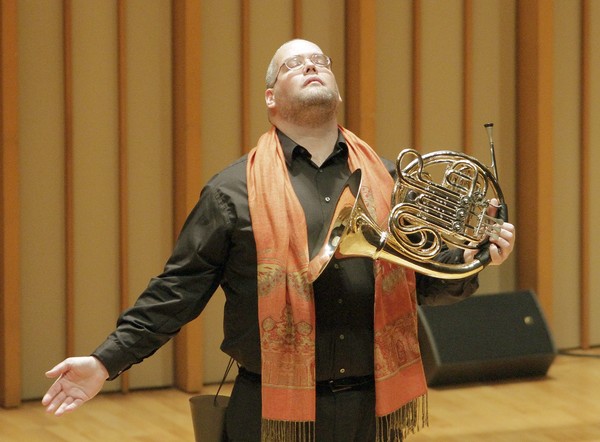
ARTS & CULTURE
Review: Encounter with postwar giants at Southwest Chamber Music festival
Premieres of unfinished works by Karlheinz Stockhausen and John Cage offer windows into the wondrous at the New Music Festival at Zipper Hall.

By Mark Swed, Los Angeles Times Music Critic
February 25, 2013
Southwest Chamber Music's 2013 L.A. International New Music Festival, in progress at the Colburn School's Zipper Concert Hall, is doing its attentive bit to broaden international musical relations. We hear too little music from Mexican, Korean or even Venezuelan composers. America and Germany lost its two greatest senior composers — Elliott Carter and Hans Werner Henze — late last year, but they have been long lost on the West Coast, where they remain ignored. Thankfully in such matters, Southwest can serve as an indispensable diplomat.
Even so, geography as we know it had very little to do with the third of the festival's four concerts Saturday night. An encounter with two giants (again German and American) of the post-World War II avant-garde at the end of their lives, the program began with the U.S. premiere of Karlheinz Stockhausen's "Nebadon." The title refers to a remote universe described in "The Urantia Book," a couple thousand pages of convoluted cosmic revelations offered up by celestial beings to the collective subconscious of a select group of Chicagoans last century.
The other premiere, this time for the West Coast, was John Cage's "Muoyce II." Subtitled "A Reading Through 'Ulysses,'" the work turns James Joyce's Dublin into auditory regions unknown, more a map of Cage's mind than anything physical you'd find in an atlas.
Both of these pieces come from projects the composers left unfinished at the time of their deaths, and no one before has had the fascinating idea to explore together the strange, and strangely parallel, realms they inhabit. In fact, once one starts digging, surprising, even eerie, coincidences between the two composers begin to appear.
Superficially, it might be a challenge to find composers who were less alike. Cage spent a good deal of his career advocating leaving the artist's ego out of the art in order to give what you don't think you like a chance. For Stockhausen, on the other hand, great art was the personification of a great ego. He came to believe he was a musical messenger from the star Sirius and most likely the reincarnation of Mahler.
But ironically, both got their ego and anti-ego inspirations similarly — Cage turning to Zen Buddhism as therapy for depression after a divorce, Stockhausen to the Hindu Indian guru Sri Aurobindo as therapy for depression after a divorce. Both composers even died alike, unexpectedly and suddenly at age 79. Cage collapsed from a massive stroke in 1992; Stockhausen collapsed from a heart attack 15 years later.
At the time of his death, Stockhausen was working on a series of 24 pieces called "Klang" (Sound), each for an hour of the day. At 5 p.m. comes "Nebadon," for solo French horn and electronics.
Southwest found an excellent horn player willing to memorize the difficult score, something Stockhausen insisted on, so that he could perform in the ritual manner the composer liked. Andrew Pelletier wore a scarf and nodded in different directions from time to time. But he never went too far, as Stockhausen's own performers sometimes have, with sacramental overstimulation.
The horn melodies are like abstract calls of nature. The electronic music swirled around Zipper like a music of the spheres. The piece lasted 21 minutes, and each of those minutes I thought a window into the wondrous.
"Muoyce II" is for a solo reader. Cage went through Joyce's "Ulysses," and by using arcane procedures distilled a version of the novel's 18 chapters to 22 typescript pages, which make no sense. Here is a line, chosen at random: "about FlynntheheatMayNoseypriest iswe same."
Cage had meant to read the text as part of a festival in Frankfurt, Germany, that celebrated his 80th birthday, but he died five weeks before and hadn't yet decided exactly how he would proceed, other than including recordings of traffic sounds from different places — what a modern-day Ulysses might encounter — as background. It is now left to others to decide what to do, and so far few have dared and none, it seems, succeeded.
Jeff von der Schmidt, Southwest's artistic director who led a two-part festival last year and the year before to celebrate the 2012 Cage centennial, was the reader. His wife, Jan Karlin, the ensemble's executive director, was here the stage director. Two of the traffic tapes have been lost, so Von der Schmidt supplied new ones taken from the Pasadena Freeway and street sounds in Hanoi, and the honking of Vietnamese motorbikes dramatically dominated the soundscape.
Cage's reading style late in his life was introverted, mellow and meditative. He trusted his material and was never afraid to put the listener to sleep. Von der Schmidt's and Karlin's solution to "Muoyce II" was dynamic and vividly dramatic, producing not a soporific effect but that of hearing a narration without knowing the narrative. The performance, moreover, impressively exulted in Joyce's language and its musical implications.
No one can be Cage, and no two readers will ever do this piece in vaguely the same way. Von der Schmidt proved that "Muoyce II" can be done as theater. A debate is sure to develop about whether it should.
Southwest will conclude its final festival program March 2 by returning home with the world premieres of new pieces by Southern Californians: Anne LeBaron and Roger Reynolds.
mark.swed@latimes.com